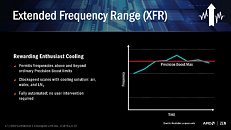Friday, February 10th 2017

AMD's "X" Nomenclature on Upcoming Ryzen Chips Related To XFR Feature
A Reddit user has used some good, old-fashioned thinking and inference (along with a good memory for details and investigative spirit) to try and shed some light on AMD's upcoming Ryzen chips - particularly, on the "X" part of their nomenclature.
As we've previously reported, upcoming AMD Ryzen chips will slot in two versions for each model: for example, there will be a R7 1700X, 8-core, 16-thread processor (with 95 W TDP), and expected to retail for $381.72, and a R7 1700 (sans "X"), also 8-core, 16-thread, with a rated TDP at 65 W, expected to retail at $316.59, almost $70 cheaper than the 1700X. Now, with AMD's promise of all Ryzen processors being multiplier unlocked (and thus user - or even through an automatic BIOS - overclockable), this would mean that acquiring the 1700X chip would somehow feel like bad business - after all, if the only difference between the two models were to be base and boost clocks (thus higher pricing and TDP), that would fall irrelevant to most power users, since the ability to overclock their Ryzen processors to those levels would be there anyway.Essentialy, AMD's "X" nomenclature regarding its upcoming Ryzen chips seems to denote the presence or absence of their touted XFR (eXtended Frequency Range) feature. This is part of AMD's SenseMI Technology suite, which aims to bring higher, intelligent performance to their Ryzen chips through the use of some particular technologies. XFR as it is, appears to be an added, automated overclocking capability to the chip, going further than the Precision Boost clocks would usually allow, supposedly scaling with the cooling performance of the end user's machine. This would fall in nicely with the rated TDP's of the non-X processors being rated at 65 W, with the X-branded, XFR-enabled processors featuring a higher theoretical TDP limit in-line with the capabilities of the XFR feature. As such, while it is true that an AMD Ryzen R7 1700 chip would also have base and boost clocks, much like their 1700X counterpart, the 1700's boost capabilities are designed for the chip not to surpass this 65 W hard limit. The 1700X, however, would be able to dynamically overclock according to the environment and cooling efficiency of the end user's rig, thus allowing it to, in some cases, hit a theoretical power consumption peak at the rated 95 W.
This theory (and AMD's strategy) would go some way to explain the high price difference between the 1700X and the 1700 R7 processors, which have a measly 100 MHz difference in their boost clocks favoring the 1700X (3.8 GHz vs 3.7 GHz on the 1700). After all, it still remains up in the air how good of an overclocker will AMD's ZEN architecture be, but a TDP difference of 30 W could go a long way overclocking-wise, especially when you consider AMD can apparently make these chips tick at 3.8 GHz with a measly 65 W TDP for an 8-core, 16-thread chip.
This strategy also makes sense in that power users who spend money on high-performance cooling solutions are probably more inclined to spend more on a CPU that promises (even if only theoretically) higher overclocking potential (we can expect these X chips to be cherry-picked samples with higher overclockability than other, non-X models). This also makes sense when one considers that the X versions of Ryzen chips are expected to ship with no cooling solution, whereas non-X models will ship with the company's "Wraith" cooling solution, more than enough for the non-power user who doesn't care about something like XFR. While it is a fact that most enthusiast users will simply buy the non-X chips and overclock them until the sky is no longer an achievement, it is also true that even some of us might feel more inclined towards simply "install and forget" high-performance, automatically-overclocked chips (also something the good Dr. Lisa Su mentioned during the "New Horizon" event, saying that XFR was "just for you enthusiast gamers").
Source:
Reddit user riuzaky2
As we've previously reported, upcoming AMD Ryzen chips will slot in two versions for each model: for example, there will be a R7 1700X, 8-core, 16-thread processor (with 95 W TDP), and expected to retail for $381.72, and a R7 1700 (sans "X"), also 8-core, 16-thread, with a rated TDP at 65 W, expected to retail at $316.59, almost $70 cheaper than the 1700X. Now, with AMD's promise of all Ryzen processors being multiplier unlocked (and thus user - or even through an automatic BIOS - overclockable), this would mean that acquiring the 1700X chip would somehow feel like bad business - after all, if the only difference between the two models were to be base and boost clocks (thus higher pricing and TDP), that would fall irrelevant to most power users, since the ability to overclock their Ryzen processors to those levels would be there anyway.Essentialy, AMD's "X" nomenclature regarding its upcoming Ryzen chips seems to denote the presence or absence of their touted XFR (eXtended Frequency Range) feature. This is part of AMD's SenseMI Technology suite, which aims to bring higher, intelligent performance to their Ryzen chips through the use of some particular technologies. XFR as it is, appears to be an added, automated overclocking capability to the chip, going further than the Precision Boost clocks would usually allow, supposedly scaling with the cooling performance of the end user's machine. This would fall in nicely with the rated TDP's of the non-X processors being rated at 65 W, with the X-branded, XFR-enabled processors featuring a higher theoretical TDP limit in-line with the capabilities of the XFR feature. As such, while it is true that an AMD Ryzen R7 1700 chip would also have base and boost clocks, much like their 1700X counterpart, the 1700's boost capabilities are designed for the chip not to surpass this 65 W hard limit. The 1700X, however, would be able to dynamically overclock according to the environment and cooling efficiency of the end user's rig, thus allowing it to, in some cases, hit a theoretical power consumption peak at the rated 95 W.
This theory (and AMD's strategy) would go some way to explain the high price difference between the 1700X and the 1700 R7 processors, which have a measly 100 MHz difference in their boost clocks favoring the 1700X (3.8 GHz vs 3.7 GHz on the 1700). After all, it still remains up in the air how good of an overclocker will AMD's ZEN architecture be, but a TDP difference of 30 W could go a long way overclocking-wise, especially when you consider AMD can apparently make these chips tick at 3.8 GHz with a measly 65 W TDP for an 8-core, 16-thread chip.
This strategy also makes sense in that power users who spend money on high-performance cooling solutions are probably more inclined to spend more on a CPU that promises (even if only theoretically) higher overclocking potential (we can expect these X chips to be cherry-picked samples with higher overclockability than other, non-X models). This also makes sense when one considers that the X versions of Ryzen chips are expected to ship with no cooling solution, whereas non-X models will ship with the company's "Wraith" cooling solution, more than enough for the non-power user who doesn't care about something like XFR. While it is a fact that most enthusiast users will simply buy the non-X chips and overclock them until the sky is no longer an achievement, it is also true that even some of us might feel more inclined towards simply "install and forget" high-performance, automatically-overclocked chips (also something the good Dr. Lisa Su mentioned during the "New Horizon" event, saying that XFR was "just for you enthusiast gamers").




71 Comments on AMD's "X" Nomenclature on Upcoming Ryzen Chips Related To XFR Feature
I'm likely wrong in that indeed only X chips are rumoured to have the afxr auto overclocking anyway making a defined difference.
Also, last I checked, Intel sells 10 overclockable processors, not 3.
Its only way out is heat or (ignorable, since it is way to small) EM radiation.
Nothing else.
Whenever that "some form of electrical energy" (not that we know many forms of it, but fuck it) is used to send a signal to cache/memory/whatever, it ends up either emitting a tiny bit of EM waves, or just heats things up ("makes molecules move faster", not 100% correct, but very close)
Bottom line: when 95W TDP rated chip consumes roughly as much as 145W TDP chip and total consumption of systems is actually about 180 watt, the 95W TDP rating is clearly BS.
What I was asking was why on earth did AMD need such bogus TDP numbers, do they really think they can get away with when nearly all reviewers do power consumption tests?
Two chips of the same design can pull different power and output different heat amounts for a given clock.
All chip companies quote tdp or how would you know how much cooling to fit, except Intel who switched to Sdp system designed power.
That's a fact.
@newtekie1 I've given up mate I've got a fx it doesn't clock high with awpm switched on...
He says you can pull more, yet produce less heat.
www.techpowerup.com/forums/threads/amds-x-nomenclature-on-upcoming-ryzen-chips-related-to-xfr-feature.230551/page-3#post-3600730
You are more than welcome to post some proof that they have a TDP hard lock though.
It's because I wasn't thermally restricted that I Know this they don't advertise it as a feature, shit no one knows what the top temp these can run at I've heard 62, 72 all sorts mine stays below 60.
Yet as I'm saying with awpm on in BIOS you won't get to 5.5 with it off I have without crashing with a kernel power error.
Check the many terminal run oc fx CPU threads on here you will find it commonly noted for max clocks turn off all the CPU features like cooln n quite ,hpc and apwm, usually ok to leave on upto 4.8 and your at 4.6.
every cpu chip has a thermal limit and if enabled it will shut your pc off ifff triggered.
And it's above the tdp not at it ,normally between 95 105 degrees.
If what you say is true. Show me your chip throttling due to a TDP limit.
With those settings off you can do what you want to the chip.
And Tdp isn't a limit more a fact.
Thermal design power in chip terms is used to rate the max thermal dissipation required during use.
After that it explains nothing about how a chip will work and I never said it did.
AMD still use tdp that same way
Intel do sort of even with Sdp.
Because of modern chips varying core frequency (note I'm not mentioning turbo) from low to high they all control there own performance in the moment and you have to bypass something in all CPUs in order to maintain a top clock ,yes or no?
So what happens when some tool tries to get 5ghz on the stock ally hsf
The CPU sees it's about to die and shuts down ,you can disable that and make it just die again yes or no?
Since the whole motherboard is being drawn into the CPU it is inevitable that the CPU will constrain control over itself and get more sensors and critical ,or not limits.
Getting back to RyZen for me it's fine that X editions have a higher tdp then none X
It's also fine that the non X will overclock but has a limit I don't see an issue Intel does the same but officially bans overclocking non endorsed chips and even frowns at OEMs trying to circumvent this.
I'll say it one more time, and that's it, I don't have a problem with the lower TDP, my problem is the lower TDP "Hard Limit".
But I don't know what you mean then because I never mentioned fx chips having a hard lock I mearly said that fx processors have a early version of it that limits overclocking if enabled.
To be fair we are only speculating at this point and I might well have started something for nothing if they don't have any limits but they will I think.
Messing with AMD overdrive software for CPUs displays some of the opportunity missed and yet to be reaped since it's very good in some ways ,going beyond what can be done just in BIOS with cpuvid tweaking etc.
Drag all that into the chip and they could pretty much configure and run themselves.
And actively limit max to be within its bin rating which is effectively what would could happen.
Again speculating I should just shut up but I'm eager for reviews.
I even explained this to you already back in post 38. And your response was that the e series FX chips TDP was locked. That isn't true.
But in part you turn off CPU features in the CPU section and motherboard parts in other areas of the BIOS.